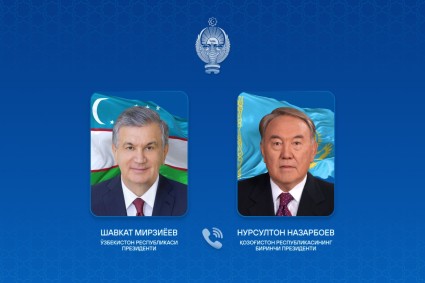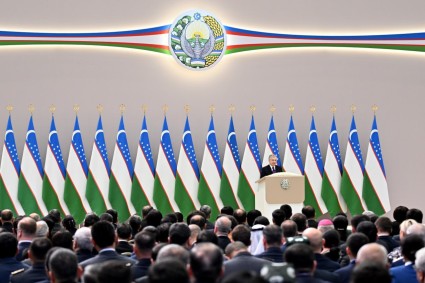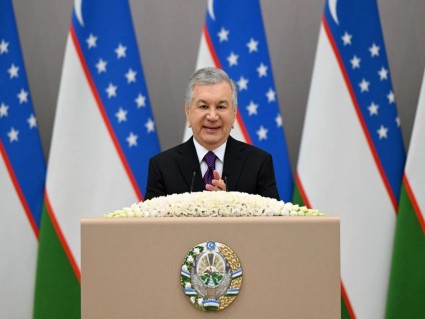IMF Managing Director Christine Lagarde made an address on May 19 at the Central Bank during her visit to Uzbekistan:
“Ladies and Gentlemen: Good morning! Assalom-Aleykum!
Governor Nurmuratov, thank you for that generous introduction. First Deputy Chairman Ishmetov, thank you for welcoming me today. It is a pleasure to be with all of you.
Before I arrived yesterday, I was told about a famous Uzbek proverb: “ A guest is greater than the father.”
As a guest in your country, I can say with confidence the hospitality of the people of Uzbekistan rivals that of anywhere in the world. All of us at the IMF are grateful. I did notice, however, this beautiful proverb makes no mention of where the mother stands in the hierarchy. I would like to think that she has a place of prominence at the very top. I will come back to this idea.
Now, of course, in addition to hospitality, there is another thing that one immediately thinks of when they arrive in Uzbekistan — history. For nearly 1,000 years, this landlocked region was a hub of trade and transformation. It was in Tashkent, Samarkand, Bukhara, the Ferghana Valley, and many other places all around us that the Silk Road grew from a simple trading route into a place that captured the world’s imagination.
Early openness to trade allowed cities to flourish. Leading scientists, craftsmen, poets, and musicians called this land their home. Where cities flourished innovation followed. In Khiva, the “father” of algebra — Mohammed Al-Khwarizmi — was born. Although many young students may wish he had never existed, today, I would like to borrow from him for the theme of my remarks: Finding an inclusive growth equation that works for Uzbekistan’s people.
In addition to Uzbekistan’s ancient history, more recent history also offers important lessons. Over the last several decades, Uzbekistan became one of the most isolated countries in the world — and failed to create a dynamic private sector with good jobs for its rapidly expanding working-age population. Simply put, Uzbekistan’s growth equation did not add up.
Uzbekistan is now changing its growth equation and aspiring once again to become a place of integration and innovation. Over just the last two years, its reforms have captured global attention. Now you have the chance to capitalize on this momentum and pursue a path that will create inclusive growth throughout the country . And in the process, you can put Uzbekistan back where it belongs — a catalyst for progress across Central Asia.
So, how can we get there? Let us think about algebra. What are the variables we need in the inclusive growth equation?
I want to begin with Uzbekistan’s own reforms and discuss the three key variablesI see: scaling up quality investments, maintaining economic and financial stability, and tackling corruption .
And then I want to talk about another important factor in our equation — the potential for Uzbekistan to accelerate growth across the entire region.
I. Uzbekistan’s New Growth Equation
a) Scaling-up Quality Investments
This first variable is scaling-up quality investments and putting those investments where they can truly help.
Before the initial wave of reforms, the vast majority of this nation’s resources were invested in state-owned enterprises that could not keep up with Uzbekistan’s demographic changes.
Over the last three decades the working-age population has surged. Today, half of the population is under the age of 30 and over 600,000 people are joining the workforce annually . [1] Many of you in this room fit that category. And yet, as you know, the number of formal sector jobs has hardly increased over the past several years.
Those who lack the necessary education and skills, and especially young people and women, are more likely to be unemployed. [2] This is a challenge, but also an opportunity. Uzbekistan has a window for rapid and inclusive growth.
Part of the solution is in education and labor market reforms that will close the skills gap. Here, the government is taking promising steps — including creating a national center to assess the quality of education across the country . New plans are underway to improve apprentice programs and build job training centers.
The government is not stopping there. Additional support is being given to families for child-care and pre-school education. Micro-credit projects for female entrepreneurs are tapping into the power of financial technology.
All of this underscores how the government has fully and courageously embraced the United Nation’s 2030 Sustainable Developments Goals (SDGs), which are designed to promote growth that is stronger, fairer, and more environmentally sound.
These reforms will build a higher skill workforce and improve companies’ overall performance.
In turn, the changes will bring much-needed foreign direct investment (FDI) into the country. But will these investments be channeled to the most competitive and profitable firms ? That has been a constant question in Uzbekistan.
The answer is: Yes — if the price is right.
A critical element to gaining more quality investments is price liberalization. The government understands this well. During the second half of 2018, this administration liberalized bread prices, removed subsidies while offsetting the effects for vulnerable families, and brought energy prices more in line with production costs.
This is an excellent start, and more will need be done to get prices right. Over the long-term, these reforms will translate into higher growth, better wages, and improved living standards.
Of course, when prices go up, it can be challenging to keep inflation in check and ensure the economy is balanced. This brings me to my second variable — maintaining economic and financial stability.
b) Economic and Financial Stability
High inflation remains a persistent threat to Uzbekistan’s economic health. Before the reforms, this country experienced high inflation rates which were not always captured by the official data. In fact, Uzbekistan’s largest banknote is 100,000, while only a few years ago it was 5,000.
Now, with the reform process, Uzbekistan has a chance to bring inflation under control and achieve greater stability in prices .
The Central Bank is addressing this challenge directly and trying to bring inflation back into the single digits. The authorities are appropriately focused on reigning in credit growth.
In 2018, the economy experienced a credit boom, with credit growth reaching 50 percent. Some of this credit financed much-needed investments in education and infrastructure. However, continuing this credit boom, especially where it fuels unproductive investments, could lead to a credit bust.
I am encouraged that the government has committed to bringing credit growth back down to a more sustainable range. The IMF will continue to work with you as you seek to meet your targets.
We will also work with you as you reform the banking sector. It is clear the banking system would benefit from more private ownership. Right now, the government manages over 85 percent of the system’s total assets.
The Central Bank recognizes the seriousness of the challenge. It has already taken concrete actions to start containing risks — including reevaluating how household loans are granted and upgrading intervention tools.
The next step will be designing a new strategy to restructure the banking system.
If done correctly, this strategy can enable a better balance between public and private investments. It is an important part of the government’s broader effort to encourage a transition from state-led to more market-based growth.
So, here, we see variables on each side of our equation.
On the one hand, the need to scale-up quality investments that create jobs and new opportunities. On the other, the need to maintain economic and financial stability.
What is missing in this balance? Continued good governance. Investments in Uzbekistan will only succeed when corruption is tackled head-on. This is my third variable.
c) Strengthening Anti-Corruption Efforts
Progress in education, infrastructure, fiscal, and financial policy is only possible when people trust their government.
When corruption becomes institutionalized, it poisons the ability of a nation to attract investors and create jobs. Young people understand this reality better than most. A recent survey of global youth showed that young people identified corruption — not jobs, not lack of education — as the most pressing concern in their own countries. [3] I wonder if those of you in this room agree.
To me, it makes perfect sense. Because corruption is the root cause of so much of the injustice people feel in their daily lives.
It is not only young people who sense the urgency of the problem. So does the government of Uzbekistan. I want to commend the efforts already underway. One of the first laws enacted in the reform process was the Law on Combatting Corruption.
Changes are now being implemented to improve public administration, modernize procurement, and help courts run more efficiently.
Foreign exchange liberalization was another highly effective step to help reduce corruption. In fact, in a recent poll, changes in the exchange rate were cited as the single most popular reform in the country.
None of these reforms could work without transparency. The publication of the first citizen’s budget was a significant milestone . So are the efforts to reducered-tape and collect tax revenue more effectively and even-handedly. Recently, our fiscal transparency evaluation recognized the progress Uzbekistan has made on its budget transparency goals. Over just the past nine months, the authorities have provided more details on how public funds are spent and discussed fiscal risks.
The work is only beginning. As President Mirziyoyev said at the United Nations last year, new digital tools can and should help restore trust in government. He is making good on that promise. Last year, the President’s online town hall site received over 2,000,000 questions. So clearly there is an interest. Many are taking notice.
This goes to show how Uzbekistan can be a model for others, and how the work done here can be a force multiplier for good throughout Central Asia. So, in the final part of my speech, I want to explore just how much Uzbekistan can be a positive influence for the entire region.
II. Accelerating Growth Across the Region
The success of Central Asia and the success of Uzbekistan are deeply interconnected.
This is only natural, since Uzbekistan is the most populous country in the region and the only country that borders each of the four other Central Asia nations. The numbers help tell this story.
A more open Uzbekistan is a game changer for regional trade. Between 2017 and 2018, as markets opened up, trade in external goods with neighboring countries jumped by approximately 50 percent .
More people and companies are coming as well. In 2018, the number of foreign citizens entering Uzbekistan doubled. The announcement of a new “Silk Visa” for Central Asia will mean even more opportunities for cooperation in the years ahead.
And, just as happened hundreds of years ago along the Silk Road, an openness to trade will lead to flourishing industries.
Think of the connections being made as we speak. New roads being built; a railway is being completed that will soon connect China, Kazakhstan, Turkmenistan, and Uzbekistan; energy networks are springing to life.
In fact, over the past year, electricity connections were finally restored between Tajikistan and Uzbekistan. Today, energy is being traded daily between these two countries.
Better connections with neighbors will also help Uzbekistan’s outer regions prosper . Previously underdeveloped areas can become new regional economic centers that facilitate trade across borders.
Here, we can draw another lesson from history. This city was originally settled because it was an oasis, a fertile area near the river. Trade helped it grow from a small settlement into a great stone metropolis. From these giant stones it gained its name — Tashkent. The lesson? What starts with a small exchange of goods can build over time into a powerful regional force.
What this means in the long-term is better jobs and higher living standards, including for women. You see, I promised you I would come back to the mothers.
Right now, Uzbekistan’s female labor force participation rate is just above 50 percent, putting it around the average of other Central Asia nations . [5] But large gaps remain between men and women in health, education, and job opportunities. These new regional connections provide Uzbekistan with a once-in-a-generation chance to continue to lift up its mothers, sisters, and daughters.
Our new research on inclusive growth in Central Asiashows that if this country could match the gender equality levels of its emerging market European peers, it would boost GDP significantly. Equally important, it would challenge the entire region to further eliminate the economic and legal barriers facing women.
This is one way Uzbekistan’s growth formula — and the region’s growth formula — can rise together.
Conclusion
I want to close by returning to the fundamentals of our equation. There is something special about Uzbekistan.
It was here that Alexander the Great found his wife, Roxana, whom he described as the most beautiful woman in the world. It was here that inspired Edgar Allen Poe to write his famous poem, Tamerlane, about the sacrifices one must make in life to achieve happiness. And it was here that a new branch of mathematics was born, one that would change the way the world approaches complex problems.
At its best, Uzbekistan has been at the crossroads of growth, opportunity, and innovation in Central Asia. At darker times, Uzbekistan shut itself off from the world. Today, there is a new equation for this country to solve. You are well on your way. If together, we find the solutions, it will not only be history that visitors think of when they come to Uzbekistan. It will be Uzbekistan’s vibrant, peaceful, and prosperous future.
Thank you very much. Katta rahmat."















